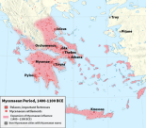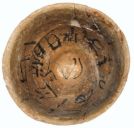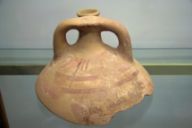Linear B
These clay tablets are found on the island of Crete, at Knossos. In the Bronze Age, one of the first complex civilizations of Europe arose on the Aegean islands: the Minoan civilization –a name that derives from the mythological Cretan king Minos. Around 1550 BCE, this civilization started to decline, possibly due to volcanic eruptions, and a new civilization emerged: the Mycenaeans,a civilization in mainland Greece, took control of the Aegean islands from c. 1450 BCE till its collapse around 1100 BCE. This clay tablet is dated around 1300 BCE and is part of this Mycenaean period.
The script on this tablet (as on the one below) is Linear B, a Mycenaean writing system. Around 1900, the British archeologist Arthur Evans discovered not only the first massive Minoan palaces at his excavation site in Knossos, Crete, but also many clay tablets with the first specimens of three different writing systems that show the development of civilizations and writing systems used on Crete. The oldest script (c. 2000 BCE) Evans found was a pictographic script that is now called Cretan hieroglyphs. Whereas these signs have a pictorial appearance, the two other scripts consist of a more linear form of writing. Evans named the oldest group of linear signs Linear A, a script that developed around 1700 BCE and was used by the Minoan civilization on Crete. Without knowing at the time that the third script was a descendant of Linear A, Evans named this third script Linear B.
Unlike Linear A, Linear B is also found on mainland Greece, at Mycenae, Thebes, Pylos and Tiryns. This and the fact that the oldest Linear B tablets on Knossos date from c. 1450 BCE suggest that the Mycenaeans, after they took control over the Minoan cities, adopted the Linear A writing system and used this evolved Linear B system for their own administration. To date more than 5000 clay tablets and around 160 painted stir-up jars with Linear B signs have been found.
It took more than fifty years after its discovery to decipher Linear B, the only one of the three Cretan scripts that is currently deciphered. Although Evans himself dismissed the possibility that Linear B was an early form of the ancient Greek language, the young architect and amateur cryptologist Michael Ventris determined eventually that Linear B was an early syllabic form of the Greek language, “difficult and archaic Greek, but Greek nevertheless” in his own words. [Linear B decoder Michael Ventris on BBC in 1952] With the help of classicist John Chadwick, he deciphered the bulk of the Linear B signs in the early 1950s by comparing certain symbol combinations with place names on Crete. We now know that Linear B consists of two different types of signs: logograms that depict an object or measure unit and 87 syllabic signs. Each syllabic sign represents either the sound of a single vowel, or a consonant with a vowel; Knossos for example is formed by three symbols representing the sounds ko-no-so.
That just a limited number of clay records with Linear B remain is not only due to the fact that (unfired) tablets were very brittle and often did not survive, but also due to the type of information on these Linear B tablets. The contents of these tablets are not so much literary works written down to be preserved, but are often of an administrative nature, consisting of lists of goods, people or animals and were, therefore, probably not intended to be long-lasting. This tablet, for example, contains a list of sheep, goat, oxen and pigs that were transported to a place called Si-ra-ro.[cf]
Furthermore, some tablets deal with religious administrative affairs. They contain lists of religious offerings and often the names of the gods and goddesses to whom the offering was addressed. Interestingly, several names of deities on these Linear B tablets are the same as those found in the Greek pantheon, such as Zeus, Hera, Poseidon and Dionysus. It has been assumed conventionally that the Aegean world lost its writing system after the collapse of the Mycenaean civilization, a period that is called the Greek Dark Ages. These unchanged names of the worshipped gods suggest, however, that there was some continuity between the Mycenaean times and the archaic Greek period. Surprisingly, the shape of these clay tablets could also support this continuity thesis.




